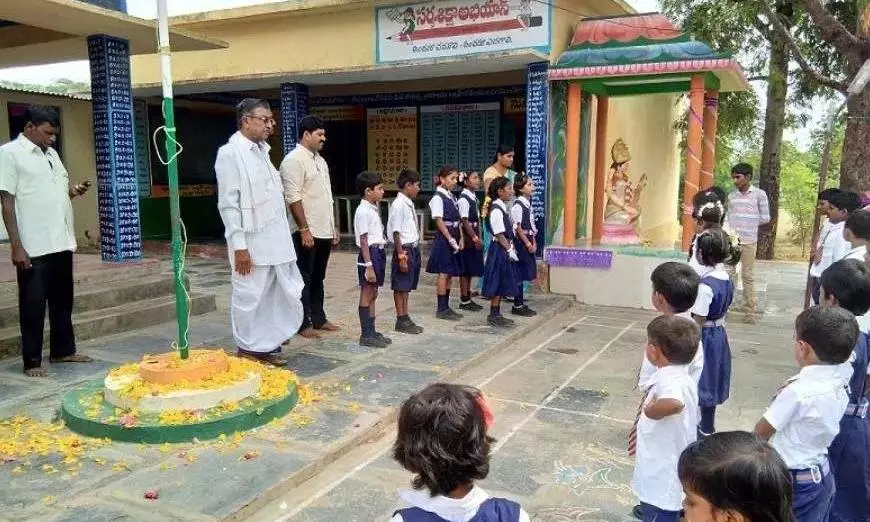
Andhra govt schools face enrolment crisis; 4,750 log no Class 1 admissions
Andhra sees major drop in student enrolment, with 3.5 lakh students shifting to private institutions, raising concerns about trust in public education system

Student enrolment in Andhra Pradesh government schools has hit a crisis point this academic year. A whopping 4,750 schools have not seen a single admission in Class 1 so far. Additionally, around 3.5 lakh students have migrated to private institutions. The total enrolment has fallen from 32.5 lakh last year to 29.65 lakh now, signalling a serious trust deficit in the public education system.
According to data released on June 30, the total enrolment from Classes 1 to 12 is 76,02,854, down from 78,69,714 last year. Class 1 admissions alone dropped from 6.87 lakh to 5.60 lakh—a decline of 1.26 lakh. Activists worry whether these children dropped out or were kept out due to administrative delays or lack of documentation. UDISE+ figures will be finalised by September 30.
Blame on rationalisation
Experts attribute the crisis to the recent “rationalisation” policy that merged schools and cancelled vacant teacher posts to cut costs. Though aimed at improving efficiency, this move forced students in rural areas to travel longer distances, prompting many parents to switch to private schools. Initiated during the Jagan Mohan Reddy government, the policy has continued under the current administration.
Merging schools without adequate transport access has proven problematic in rural areas. Though the government claims only low-enrolment schools within one kilometre were merged, closures and transfer of teachers have disrupted local education. Critics argue the policy prioritised cost savings over educational quality and long-term system stability.
Also read: What PARAKH 2024 survey tells us about learning gaps among Indian school students
Parents prefer private schools
Not only that, parents are increasingly opting for private institutions, tempted by English-medium education, modern facilities, and better teaching methods. Government schools often struggle with the basics—such as clean toilets, safe drinking water, and proper classrooms—despite spending Rs 2,000 per student annually on hygiene. Only a few schools reflect this investment.
To overcome this crisis, the government must improve infrastructure, expand teacher training, and ensure better school access in rural areas. Introducing English-medium education in government schools could help them compete with private institutions. Restoring public confidence will require transparency and quality-focused reforms.
Parents’ concerns grow
Andhra Pradesh Parents Association (PAAP) president Sikharam Narahari questioned the disappearance of 2.66 lakh students from school rolls this year and demanded a government white paper on actual enrolment. He also urged the Centre’s intervention.
However, Education Commissioner S Suresh Kumar has dismissed the concerns as “premature”. He has stated that admissions continue until August and that stricter Aadhaar-based verification and de-duplication processes have led to more accurate, though seemingly lower, figures. Many students are yet to complete verification, he added.
Also read: Malala Day spotlights her fight for girls' education and equal rights
Calls for enrolment drive
Despite official assurances, parent bodies and child rights activists are urging an emergency enrolment campaign to identify and reintegrate out-of-school children. They demand an independent audit of enrolment data, arguing that accurate numbers are vital for planning and implementing welfare schemes.
Parents have voiced concerns that the school education website lacks basic information like student and teacher numbers per class. While Class 1 enrolments must be recorded, officials have not published updated figures. This lack of transparency contradicts claims that student enrolment is on track.
High dropout after Class 10
In fact, not only schools, admissions in government junior colleges have also declined—from 1,27,270 last year to 99,323 now. Private colleges saw a loss of over 62,000 students, while aided colleges showed a drop by 1,331.
Many poor students drop out after passing Class 10, with over 26,000 not enrolling in Intermediate education. But now there is growing public pressure for the government to track and address the reasons behind these dropouts.
Education Minister Nara Lokesh has launched parent-teacher meetings and regular reviews. He has pledged a responsive digital tracking system for all students and assured that no child will be left behind.
(This story was originally published in The Federal Andhra Pradesh)

